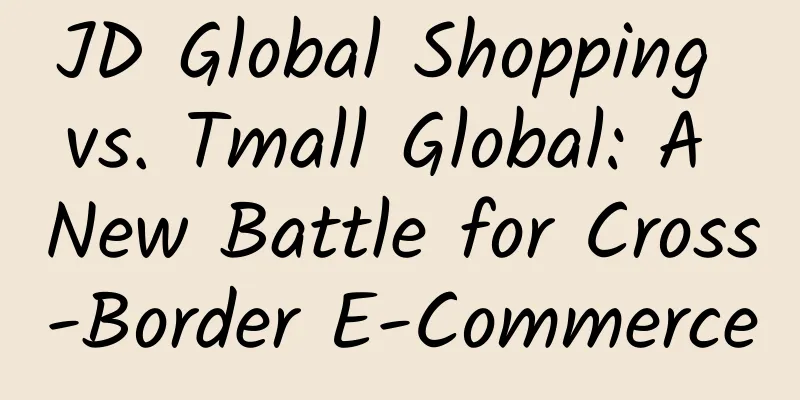JD Global Shopping vs. Tmall Global: A New Battle for Cross-Border E-Commerce

|
Cross-border e-commerce is a hot area in 2015. The Premier mentioned it many times in the government work report. In the strategy of going global, cross-border e-commerce has been given high expectations and is at the forefront of explosive growth. Driven by national strategies such as the Belt and Road Initiative and Internet Plus, China has more and more pilot bonded areas, and the overall policy is becoming clearer. Cross-border e-commerce has ushered in the best development opportunity period. Tmall Global was launched in February 2014, and JD Global Shopping was launched in April 2015. JD's early pilot cross-border e-commerce overseas shopping will be fully upgraded and switched to the global shopping platform. In just one year, the two e-commerce giants have fully rolled out their layout in cross-border e-commerce, seizing the bonus period of cross-border e-commerce. Due to special scenarios such as cross-border and cross-language, cross-border e-commerce is more complicated than the usual e-commerce model. There are great differences in various aspects such as product management, warehousing logistics, and after-sales service. Even for the two giants JD.com and Tmall, competing for the new cross-border e-commerce landscape is a meticulous and long process. Both are cross-border e-commerce companies, but their models are very different JD Global and Tmall Global are both cross-border e-commerce platforms, but the difference is that the former is overseas direct purchase + open platform, while the latter is a pure platform model. From the supply chain model, Tmall Global is mainly a bonded stocking model, while JD Global adopts three models: bonded collection, bonded stocking, and overseas direct mail. The Tmall International model is simpler to manage, and the supply chain pressure is concentrated on the merchants; the JD Global model requires very precise management, and the supply chain pressure is borne by JD and the merchants. Tmall Global continues to adopt a pure platform model and adopts a strategy of high technical service fees, while JD.com adopts an overseas direct procurement and self-operation + open platform model with lower technical service fees. From the perspective of the platform operation model, Tmall Global ensures that its own platform will not lose money, while JD.com Global Shopping ensures that merchants will not lose money. The business philosophy of the two platforms is quite different. The overseas direct purchase model may be JD.com's killer feature. JD.com started out by relying on its own independent B2C business, which has accumulated core competitiveness in supply chain management and other aspects. Overseas direct purchase is JD.com's way of replicating its own B2C self-operated legendary story in the cross-border e-commerce field, and will also become the experience competitiveness of JD.com Global Shopping. Tmall International adheres to the concept of Alibaba's light model, and it is basically impossible and difficult to achieve overseas direct purchase. Therefore, while JD.com Global Shopping is striving for scale, it will definitely magnify its experience advantage. JD.com is walking close to the ground, while Tmall is flying by holding onto trees JD.com and Alibaba have always had quite different business philosophies, temperaments, and methods of play. Judging from Tmall’s extensive management style in the early years in order to snipe JD.com, Tmall International is likely to adopt relatively extensive management in exchange for rapid growth in order to grab market share, while JD.com will maintain a relatively stable growth rate because it has always insisted on a heavy experience model. JD.com was busy with its IPO in the first half of 2014, while Tmall Global launched a cross-border e-commerce platform ahead of it. JD.com Global Shopping will surely have more moves after its launch. Since Tmall Global is a pure platform model, it can move faster. At the same time, Tmall also needs a good first-mover position, which is Alibaba's consistent style. Before JD.com officially launched Global Shopping, it had already laid out cross-border e-commerce projects such as the Korean Pavilion and the French Pavilion. Liu Qiangdong personally met with the French Prime Minister and the South Korean Minister to discuss cooperation. Although the two pavilions have been online for a short time, they have rich categories and good sales. The launch of the Global Shopping platform now means the in-depth layout of cross-border e-commerce and the advancement of JD.com's internationalization strategy. Whether you are flying by holding onto a tree or walking close to the ground, you can’t do without the big environment. Since the pilot of cross-border e-commerce bonded areas is still in the process of continuous trial, the overall scale of cross-border e-commerce is not particularly large, and the pressure of customs clearance and other work is relatively small. This also determines the development speed required by cross-border e-commerce platforms. In this regard, Tmall Global and JD Global Shopping are equal, so in terms of cross-border e-commerce, they are generally on the same starting line. eBay joins hands with JD.com, a gentleman's revenge, exactly ten years later That year, eBay left sadly, with countless emotions and pain in its heart, and all kinds of emotions towards Alibaba and Jack Ma. When the cross-border e-commerce opportunity came, eBay joined hands with JD.com without hesitation, and made a comeback with the help of JD.com platform. It has been ten years since the gentleman's revenge. The e-commerce landscape in China is relatively clear. It is impossible for eBay to come back on its own, and that would not be meaningful. However, coming back through the cross-border e-commerce model with the help of the JD platform will give eBay's high-quality merchants an opportunity to enter the vast Chinese market. eBay can be said to have returned to the Chinese market in a roundabout way. JD.com can leverage eBay's overseas merchant resources to quickly build up its global shopping merchant scale, making the path to overseas investment shorter and faster. eBay's best way to take revenge is to help JD.com. The enemy of my enemy is my friend. eBay has emerged as an X factor, making the competition between JD Global Shopping and Tmall International very interesting. Alibaba's advantage is the scale of Chinese merchants, eBay's advantage is the scale of American merchants, and JD's advantage is its self-operated and supply chain system. If JD can make good use of eBay's role as a bridge, its global shopping business will grow at a gratifying rate and will be very competitive. When gods come in, little ghosts may suffer Although the two e-commerce giants were not the first to enter the cross-border e-commerce, cross-border e-commerce is currently mainly aimed at Chinese consumers, which means that giants with a large user base have the power to sweep away thousands of enemies. After the launch of JD Global Shopping, the two giants, JD and Tmall, will set off an industry reshuffle in the cross-border e-commerce field. JD will definitely play the quality card and self-operated card, while Tmall should play the scale card. The entry of the gods, no matter what cards they play, may not be good cards for small and medium-sized cross-border e-commerce companies. Whether it is transformation or the coffin board, you have to be prepared. Cross-border e-commerce startups should also be prepared to adjust their models or category strategies. In the future, cross-border e-commerce will inevitably move towards the B2C-style standardized path. The majority of consumers will quickly migrate to large platforms, and the consumption habits of cross-border e-commerce will soon change. Entrepreneurs in this field have to rethink their position in the industrial chain. Although the cross-border e-commerce industry is in a period of dividends, it is about to enter a period of rapid reshuffle, which sounds really cruel and shed a few tears. However, from a more macro perspective, the entry of JD Global Shopping and Tmall International will rapidly expand the scale of cross-border e-commerce and make the non-standard cross-border e-commerce model die out soon, which is a good thing for consumers. |
<<: The Bubble and Truth of Internet+
>>: How can programmers achieve "fast programming speed and few bugs"?
Recommend
Cong Fei uses 5 OH card methods to talk to others
Cong Fei talks about the five OH card resources: ...
Kuaishou Operation: Kuaishou Merchant Account Certification Process
1. What is Kuaishou Merchant Account? Kuaishou de...
How did Meilishuo attract its first 1 million users?
Meilishuo was founded in 2009 and now has nearly 1...
The marketing logic behind Yuanqi Forest’s “brand identity”
Genki Forest changed its logo, changing the Japan...
Android: Visibility and accessibility of exported components
In Android development, android:exported is an at...
How to write an event plan? 4 basic elements to prioritize
The event background, purpose, theme, and time ar...
Qingyi hits the board master + CJ low-absorption master hot money actual combat combination punch Qingyi hits the board + CJ low-absorption
Qingyi hitting the board master + CJ low-absorpti...
What should I do if there are too many credit inquiry records? This is how it is handled
How to deal with too many credit inquiry records?...
How to join the live broadcast on DianTao? DianTao Live Registration Process
Young anchors also want to join the DianTao platf...
Today's headlines traffic diversion skills and advantages
A bird of prey, eating large chunks of meat. I ha...
Zhihu Operation: How to receive 10,000 yuan in advertising fees for one answer on Zhihu
On Zhihu, I earned 10,000 yuan in advertising fee...
5 Brand Promotion Strategy Models
The market is changing, the industry is changing,...
2020 Beginner’s Guide to Private Domain Traffic System!
What is private domain traffic ? This is a relati...
Symantec: Millions of Android apps are malware
Editor's note: This seems to need no further ...
How to make users addicted to your product? These 4 steps are required
What would happen if users fell in love with prod...






![[Prize Collection] The fourth issue of Aiti Tribe Story Collection looks forward to your sharing](/upload/images/67ebd63b31006.webp)


